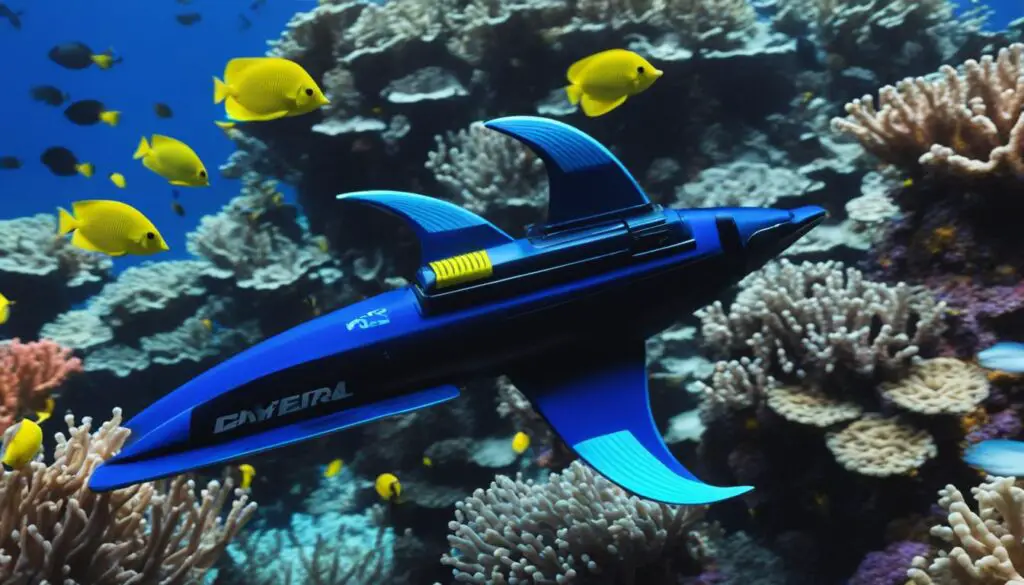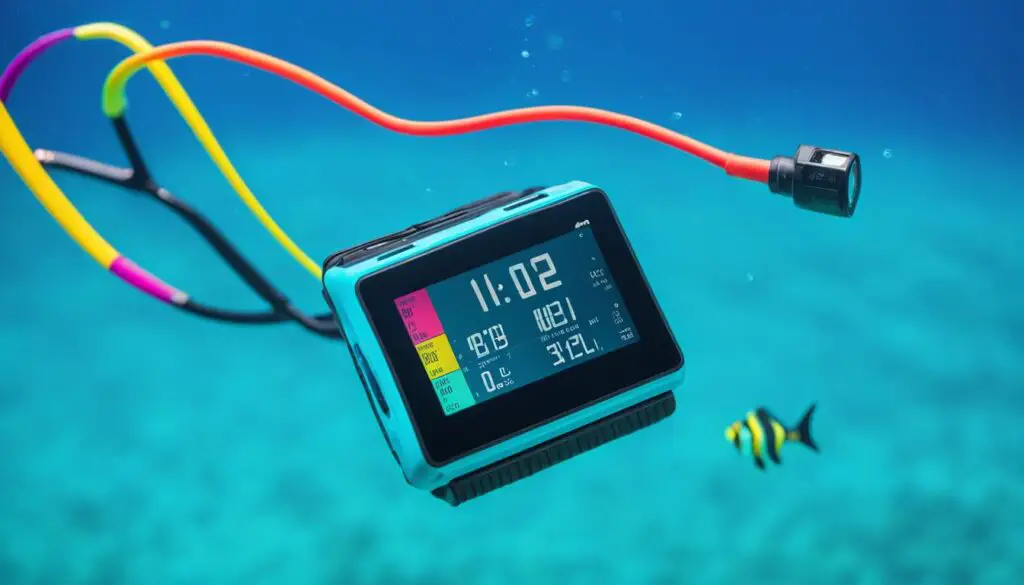Whether you’re an experienced diver or just getting started, having the right diving gear is crucial for a safe and enjoyable underwater adventure in tropical waters. In this comprehensive guide, we will explore the must-have diving gear essentials specifically designed for diving in tropical waters. From masks and snorkels to fins and wetsuits, we’ve gathered all the information you need to make the most of your undersea exploration.
Key Takeaways:
- Invest in high-quality diving gear essentials for a safe and enjoyable diving experience in tropical waters.
- Ensure your diving mask has tempered glass lenses for clear vision and a comfortable fit.
- Choose a snorkel with a splash guard and purge valve for easy breathing at the surface.
- Opt for open-heel fins with adjustable straps for efficient movement and maneuverability underwater.
- Consider the water temperature when selecting a wetsuit for exposure protection and comfort.
Masks and Snorkels: Clear Vision and Easy Breathing
When diving in tropical waters, having a high-quality diving mask and snorkel is essential. These pieces of gear provide you with clear vision underwater and easy breathing while at the surface.
For clear vision, look for diving masks with tempered glass lenses that offer a wide field of view. The tempered glass is more resistant to scratching and shattering, ensuring a long-lasting and safe diving experience. Additionally, opt for a mask with a comfortable, leak-free fit to prevent water from entering and obstructing your vision. Silicone skirts not only provide a better seal but are also more durable compared to rubber skirts.
To ensure easy breathing while at the surface, choosing the right snorkel is crucial. Look for snorkels with a splash guard, which prevents water from entering the tube during surface swimming. This feature helps maintain a clear breathing path, allowing you to focus on enjoying the vibrant marine life. Additionally, opt for a snorkel with a purge valve, which makes it effortless to clear any water that does enter the snorkel tube.
Equipped with these features, your diving mask and snorkel will provide you with optimal comfort and functionality, allowing you to fully immerse yourself in the underwater world.
| Diving Masks Features | Snorkels Features |
|---|---|
| – Tempered glass lenses | – Splash guard |
| – Wide field of view | – Purge valve |
| – Comfortable, leak-free fit | |
| – Durable silicone skirts |
By investing in high-quality masks and snorkels, you can ensure a comfortable and enjoyable diving experience with clear vision and easy breathing.
Fins: Efficient Movement and Maneuverability
When it comes to diving in tropical waters, having the right pair of diving fins is essential. Diving fins not only propel you through the water with ease but also enhance maneuverability, allowing you to navigate through the underwater world effortlessly.
For optimal performance, I recommend choosing open-heel fins that can be worn with booties. This combination provides added comfort and protection, especially when exploring rocky or uneven terrains. Look for fins with adjustable straps, ensuring a secure fit that won’t slip off during your dives.
The design of diving fins plays a significant role in their efficiency. Fins with longer blades and channels or vents provide enhanced propulsion, allowing you to cover more distance with each kick. These fins are perfect for open water dives where efficient movement is key.
On the other hand, if you plan on exploring narrow caves or maneuvering through tight spaces, shorter fins are more suitable. These fins offer greater maneuverability, allowing you to make precise movements without getting caught on underwater obstacles.
When choosing diving fins, it’s important to find a balance between performance and comfort. Opt for fins that are lightweight yet sturdy, ensuring that you can move effortlessly without feeling weighed down. Remember, your diving experience should be comfortable and enjoyable, and the right pair of fins plays a vital role in achieving that.
To give you a visual representation of the different types of diving fins available, here’s a comparison table:
| Fins Type | Blade Length | Features |
|---|---|---|
| Long Fins with Channels/Vents | Long | Enhanced propulsion |
| Short Fins | Short | Better maneuverability |
Note: The data presented in this table is for illustrative purposes only.

By investing in the right pair of diving fins, you can ensure efficient movement and better maneuverability during your tropical dives. Whether you’re exploring vibrant coral reefs or swimming alongside graceful marine creatures, the right fins will enhance your underwater experience and allow you to make the most of your time beneath the surface.
Exposure Protection: Wetsuits for Comfort and Safety
In tropical waters, a wetsuit is still necessary to provide exposure protection and enhance your comfort and safety during dives. Choosing the right wetsuit can make a significant difference in your overall diving experience.
When selecting a wetsuit, consider its weight, thickness, and the water temperature. Opting for a lightweight wetsuit ensures that you can move freely and comfortably in the water. The thickness of the wetsuit should be appropriate for the specific water temperature, providing adequate insulation without overheating or compromising mobility.
Types of Wetsuits:
1. Shorty wetsuits: Ideal for warm waters, shorty wetsuits offer exposure protection for your core while allowing greater flexibility in your limbs. With shorter arms and legs, they provide the right balance of comfort and freedom of movement.
2. Full-length wetsuits: Suitable for cooler waters, full-length wetsuits provide coverage for your entire body, keeping you warm during extended dives. The added insulation and coverage protect you from chilly water temperatures, ensuring your safety and comfort.
When it comes to material, neoprene is the go-to choice for wetsuits. Neoprene offers excellent elasticity, allowing the suit to conform to your body shape while providing insulation against the water’s cooling effects.
Additionally, certain features can enhance the durability and convenience of your wetsuit. Reinforced knee pads provide extra protection during dives, especially if you plan on exploring rocky terrains. Back zippers allow for easy entry and exit, simplifying the process of putting on and removing the wetsuit.
Remember, your wetsuit is not only for exposure protection but also plays a crucial role in your comfort and safety underwater. Take the time to find a wetsuit that fits you well and meets your specific diving needs. With the right wetsuit, you can have a comfortable and secure diving experience, even in tropical waters.
Dive Computer: Dive Planning and Monitoring
A dive computer is an essential tool for dive planning and real-time monitoring of your dives in tropical waters. These compact devices provide important information such as depth, dive time, decompression limits, and no-decompression limits, ensuring that you stay within safe diving parameters.
When choosing a dive computer, look for one that is user-friendly and has an intuitive interface, allowing for easy navigation and understanding of the displayed data. This will enable you to plan your dives effectively and make real-time adjustments if needed.
Consider features like multiple gas mix compatibility if you plan on advanced diving that involves using different diving gases. This functionality allows you to accurately track your nitrogen exposure and switch between gas mixes during your dives. Additionally, some dive computers offer extra features such as a compass for underwater navigation and dive log memory to review and analyze your past dives.
Investing in a reliable dive computer gives you the peace of mind to dive confidently and safely. It serves as a valuable tool for tracking your dive profile, managing your dive time, and avoiding decompression sickness. With the dive computer acting as your trusted companion, you can focus on exploring the breathtaking underwater world without worrying about exceeding your limits.

Key Features of Dive Computers:
- Real-time depth and time tracking
- Decompression and no-decompression limit calculations
- Multiple gas mix compatibility
- Intuitive user interface
- Compass for underwater navigation
- Dive log memory for reviewing past dives
“A dive computer is like having a personal dive guide on your wrist. It provides you with crucial information to ensure a safe and enjoyable diving experience in tropical waters.” – Emily Johnson, experienced diver
Conclusion
Having the right diving gear essentials is crucial for a rewarding and safe underwater experience in tropical waters. Each piece of gear, from masks and snorkels to fins and exposure protection, plays a vital role in enhancing your adventure beneath the surface.
By choosing high-quality gear that fits you well and meets your specific needs, you can dive comfortably and confidently, immersing yourself in the wonders of tropical marine environments. A well-fitting diving mask and snorkel will provide clear vision underwater and easy breathing at the surface, while fins with efficient movement and maneuverability will enhance your dives.
Don’t forget to invest in exposure protection, such as a wetsuit appropriate for the water temperature. This will not only keep you comfortable during your dives but also provide an added layer of safety. Finally, a dive computer will be your invaluable companion, assisting in dive planning and real-time monitoring.
So, grab your gear and venture into the tropical waters, ready to explore and create unforgettable memories beneath the surface. Happy diving!
FAQ
Why is having the right diving gear essential for diving in tropical waters?
Having the right diving gear is crucial for a safe and enjoyable underwater adventure in tropical waters. It ensures that you have clear vision underwater, easy breathing at the surface, efficient movement and maneuverability, exposure protection, and the ability to plan and monitor your dives.
What should I look for in a diving mask for diving in tropical waters?
Look for masks with tempered glass lenses that offer a wide field of view and a comfortable, leak-free fit. Silicone skirts provide a better seal and are more durable than rubber skirts.
What features should a snorkel have for diving in tropical waters?
Choose a snorkel with a splash guard and a purge valve for effortless clearing. These features ensure easy breathing and prevent water from entering the snorkel while exploring the marine life.
What type of fins are recommended for diving in tropical waters?
Opt for open-heel fins that can be worn with booties for added comfort and protection. Look for fins with adjustable straps to ensure a secure fit. Additionally, consider the design of the fins, as longer fins with channels or vents enhance propulsion, while shorter fins are more suitable for maneuvering in tight spaces.
What should I consider when choosing a wetsuit for diving in tropical waters?
Consider the water temperature and choose a wetsuit with an appropriate thickness. Shorty wetsuits are ideal for warm waters, while full-length wetsuits provide coverage for cooler waters. Look for wetsuits made of neoprene materials with good elasticity and insulation properties. Features such as reinforced knee pads and back zippers can also enhance durability and convenience.
Why is a dive computer important for diving in tropical waters?
A dive computer is an essential tool for dive planning and real-time monitoring of your dives. It provides information such as depth, dive time, decompression limits, and no-decompression limits, helping you stay within safe diving limits. Look for a user-friendly dive computer with an intuitive interface and consider additional features such as multiple gas mix compatibility, a compass, and dive log memory.
